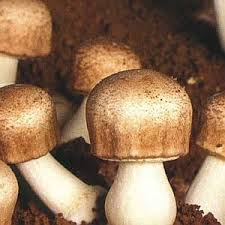Agaricusblazei Murrill mushroom (ABM), originally native to a small village, name Piedade, in the highland areas of Atlantic forest in Brazil. It is an edible mushroom popular withseveral names such as “the Almond Mushroom”, “the Sun Mushroom”, or “the Gods Mushroom”.It has been studied several times as a functional food as well as a medicinal product. The documented health benefits of ABM resulted in their use as anti-oxidant, anti-diabetic, cholesterol-lowering,immunomodulatory, anti-allergic, kidney protective, and anti-microbial agent in modern times.
Anti- Cancerogenic Extracts of ABM
Chemical identification and quantification of specific compounds responsible for the potential benefit from ABM extracts reveals that it contains several anti-cancer substances such as ergosterol, β-glucans, Pyroglutamate, Polysaccharides (1-6)- β-backbone, Lignin derivatives and Polysaccharide–protein complex as well.These compounds poses either antiangiogenic, antiblastic or immunostimulant effects in the form of anti-cancerogenic response. However, several safety issues are linked with these compounds. For instance, the immunostimulation after the ingestion of polysaccharides is probably useful in cancer patients if it does not give rise to pharmacological interferences.
Reported Anti-Cancer Action (In-vivo, in-vitro study outcomes)
Action mechanism of ABM and its components is beingevaluated by large variety of experimental data especially for its anti-cancerogenic effect. ABM extractssuch as agaritine, alpha-(1–>4)-glucan-beta-(1–>6)-glucan-protein complex polysaccharide and Blazein are reported to have anti-tumor activity against leukemic cell line U937,)sarcoma in animal models, lung cancer (LU 99) as well as stomach cancer cells (KATO III) cells respectively.The anti-tumor activity of ABM extracts has been reported to occur by apoptosis mediated cancer cell death, tumor inhibition by host- mediated mechanismsetc. Likewise, another study has been reported to suggest that the broth of ABM may directly inhibit the growth of prostate cancer cell via an apoptotic pathway and suppress prostate tumor growth via antiproliferative and antiangiogenic mechanisms. Therefore,ABM might have the potential therapeutic use in the prevention and treatment of human prostate cancer as well.
REFERENCES:
- Firenzuoli F, Gori L, Lombardo G. 2008. The Medicinal Mushroom Agaricus blazei Murrill: Review of Literature and Pharmaco-Toxicological Problems. Evidence-based complementary and alternative medicine : eCAM 5:3-15
- Wang H, Fu Z, Han C. 2013. The Medicinal Values of Culinary-Medicinal Royal Sun Mushroom (Agaricus blazei Murrill). Evidence-based complementary and alternative medicine : eCAM 2013:842619
- Akiyama H, Endo M, Matsui T, Katsuda I, Emi N, et al. 2011. Agaritine from Agaricus blazei Murrill induces apoptosis in the leukemic cell line U937. Biochimica et biophysicaacta 1810:519-25
- Gonzaga ML, Bezerra DP, Alves AP, de Alencar NM, Mesquita Rde O, et al. 2009. In vivo growth-inhibition of Sarcoma 180 by an alpha-(1–>4)-glucan-beta-(1–>6)-glucan-protein complex polysaccharide obtained from Agaricus blazei Murill. Journal of natural medicines 63:32-40
- Kobayashi H, Masumoto J. 2010. Endotoxin contamination of Agaricus blazei Murrill extract enhances murine immunologic responses and inhibits the growth of sarcoma 180 implants in vivo. Journal of environmental pathology, toxicology and oncology : official organ of the International Society for Environmental Toxicology and Cancer 29:159-68
- Itoh H, Ito H, Hibasami H. 2008. Blazein of a new steroid isolated from Agaricus blazei Murrill (himematsutake) induces cell death and morphological change indicative of apoptotic chromatin condensation in human lung cancer LU99 and stomach cancer KATO III cells. Oncology reports 20:1359-61
- Yu CH, Kan SF, Shu CH, Lu TJ, Sun-Hwang L, Wang PS. 2009. Inhibitory mechanisms of Agaricus blazei Murill on the growth of prostate cancer in vitro and in vivo. The Journal of nutritional biochemistry 20:753-64

